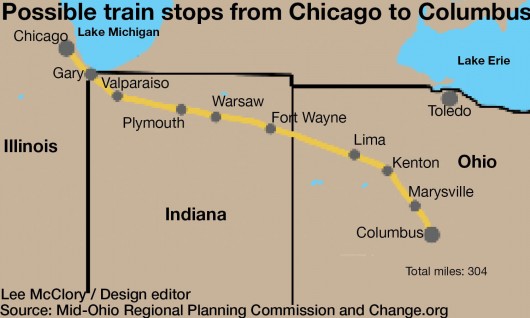More steps are being taken in plans to build a high-speed train connecting Columbus to Chicago.
The Mid-Ohio Regional Planning Commission is “ready for the next phase of due diligence to continue exploration,” of the proposed high speed train, according to a Mid-Ohio Regional Planning Commission press release.
The 300-mile railway would make stops at 9 cities along the route from Columbus to Chicago, the release said.
The train’s initial proposal was made in 2004, said Thea Walsh, director of transportation systems and funding at MORPC in an email.
The Northeast Indiana Passenger Rail Association led a feasibility and business plan to evaluate the case in 2013, the release said.
And since the completion of the study, the MORPC staff has taken the next step and worked with other metropolitan planning agencies to complete a rail service development plan, Walsh said.
The initial study by NIPRA estimated the total cost of the railway line to be $1.29 billion, or about $4 million per mile, she said. However, the estimated return on the project is slated to be $6.24 billion.
So far, the feedback for the proposed plan has been positive, Walsh said.
“(The feedback) comes from local stakeholder groups and communities interested in hearing more about how it could benefit their community,” she said.
According to an NIPRA release, the Columbus metropolitan area population is the largest in the U.S. that does not have any type of passenger railway.
The initial study also projected significant regional economic benefits, Walsh said. Those benefits include 26,800 full-time jobs for 30 years, an estimated 12,000 construction jobs generated while the passenger rail is being built, and $2.6 billion in increased joint economic development opportunities for communities along the corridor, she said.
According to a 2012 study by the Environmental Law and Policy Center, there are more than 460 companies in the Midwest high-speed rail supply chain, including 122 in Ohio.
Some Ohio State students from Chicago are excited about the prospect of a train connecting the two cities.
Ellen Finneran, a fourth-year in accounting, said she goes home once per semester, but if a railway was built she would go home more frequently.
“I think it’s a really good idea because a lot of people in Ohio, especially Columbus, are from Chicago. Right now the only option (for public transport) is the Megabus, but that’s limited with the times it’s available, so that’s pretty annoying,” Finneran said. Megabus is a bus service that operating in the U.S. and Canada.
The high-speed train would make the Chicago-to-Columbus travel time three hours and 45 minutes, compared to an almost six-hour drive.
“It’s really long to drive by yourself, and as a student with work, it would be good to have public transport to get school work done on my travel,” Finneran said.
Even students who have never been to Chicago said they would use the railway.
“I think it’d be fun to take a weekend trip there,” said Haley Waldo, a first-year in exploration from Ohio. “Although it would depend on the ticket prices.”
The proposed plan has received support from Transit Columbus, which has a signatures on petition website for the train.
According to its website, Transit Columbus is a nonprofit organization that’s mission is to have “an integrated public transportation system for the people of Central Ohio.”
The petition had more than 5,900 supporters as of Monday evening.
MORPC staff have also been working with OSU students by getting them involved in the planning.
“Staff is working with a studio class at the Knowlton School of Architecture to facilitate local project ideas that could be considered for this rail line,” said Laura Koprowski, director of public and government affairs at MORPC.
The cities along the proposed route include Columbus, Marysville, Kenton and Lima in Ohio, and Fort Wayne, South Bend, and Gary in Indiana, and Chicago, Walsh said. However, the release said other cities along the route are set to include Warsaw, Plymouth, Valparaiso and Gary in Indiana.
As of now, there is no projected start date.
Correction: Oct. 15, 2014
An earlier version of the graphic in this story incorrectly spelled the names of the cites Plymouth and Valparaiso.



